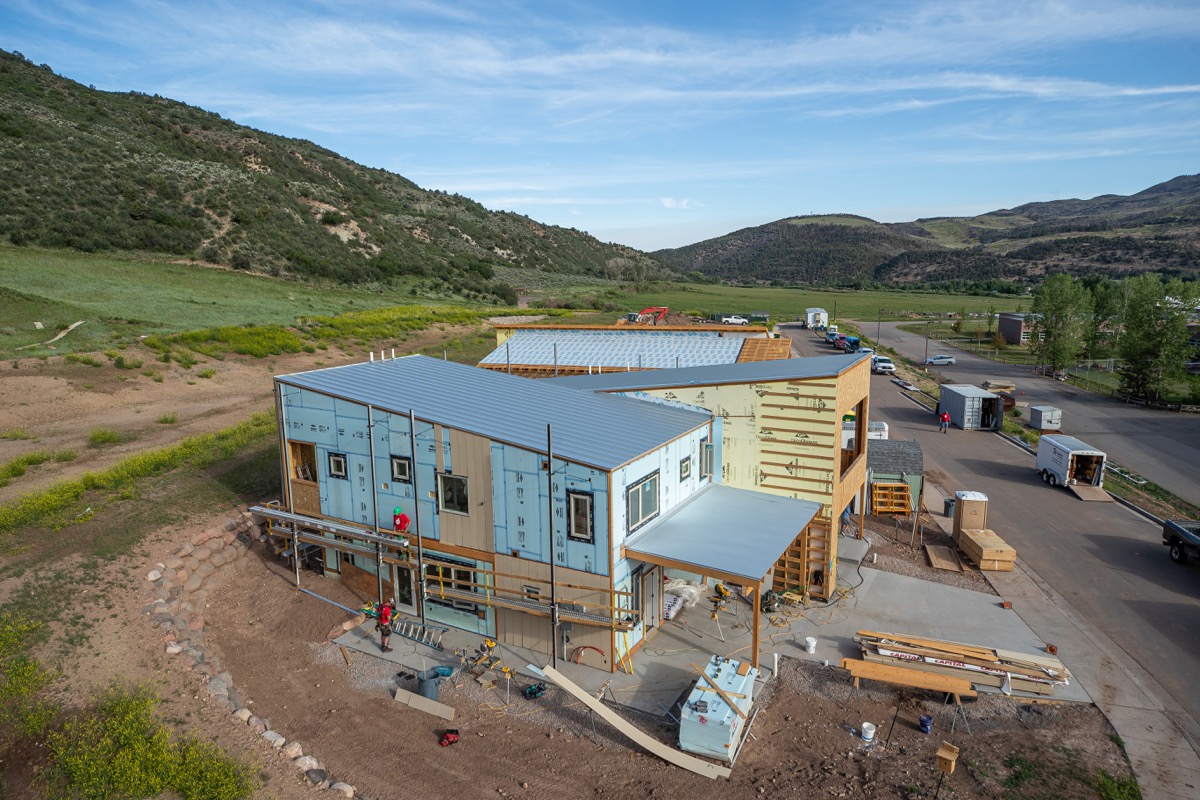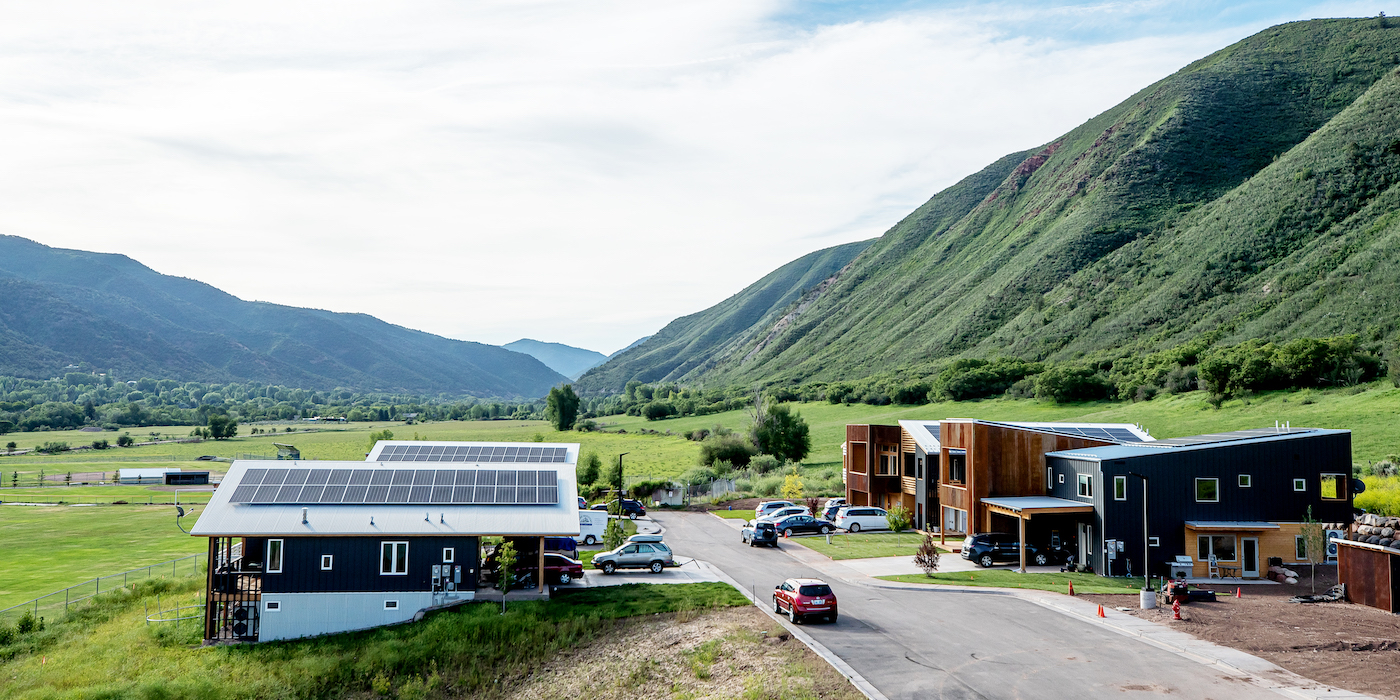Case Study: Basalt Vista Affordable Housing Community, Basalt
About the development
Basalt Vista Affordable Housing Community (Basalt Vista) is a 27-unit permanently affordable homeownership development located in Basalt. It is the product of an innovative development partnership between Habitat for Humanity of the Roaring Fork Valley (Habitat), Roaring Fork Schools, and Pitkin County. The duplex and triplex homes contain a mix of two-, three-, and four-bedroom units. It is located on a site directly behind Basalt High School and provides affordable housing opportunities for teachers and other essential workers who work within Pitkin County.
In addition to having affordable price points, Basalt Vista homes are affordable to own and maintain from an energy efficiency standpoint. Each home is net-zero, meaning that it generates more electricity than it uses. The development utilizes green-building technologies that benefit both residents and the environment.
The development is structured as three phases of nine homes each.
Contributors to success in development
Creative partnerships. Basalt Vista emerged out of years of dialogue between Habitat and other partners who created the development concept. Each partner had resources and its own stake in the outcome. Roaring Fork Schools owned the vacant land and was interested in developing more affordable housing for its teachers. Pitkin County also recognized the need for affordable housing options for its workforce and had resources it was willing to contribute toward the infrastructure of the development. Habitat had the developer knowledge and problem-solving skillset that enabled the development to come together.
Each core partner was able to contribute its resources while also achieving its goals. In return for contributing the $3 million parcel to the development, the school district was able to secure a designated number of affordable units for its teachers. The remainder of the units are set aside for essential workers who work within Pitkin County in return for the county’s contribution of $3.2 million in infrastructure costs.
Additional partners also contributed to the development. The Town of Basalt invested in the development by waiving certain fees, supporting the playground construction, and providing a grant toward the energy efficiency upgrades. Holy Cross Energy brought their resources to support the energy efficiency and net-zero approach, including battery back-ups for the first four homes. DOH provided grant funding. Solar panels were supported through a grant from CORE, an energy resource entity in the county. The resources and expertise these partners collectively brought to the table were major contributors to the development’s success.
Community support and compromise. The broader community was generally supportive of this development, as many stakeholders recognized the need for improving and maintaining housing affordability in the county. The county already has many deed-restricted affordable units and has requirements for affordable units to be included in new developments, so this development was already aligned with community priorities.
One aspect of the development that required compromise with the community was regarding the density of units. Although the site could have accommodated some level of additional density, the development partners were able to effectively compromise to maintain the community’s character while still meeting affordable housing goals.
Building and hiring capacity. Habitat recognized that this development would be of a larger scale than others it had previously developed. Fortunately, board members who had experience with larger developments were able to counsel and help build their staff capacity.
In addition, to commit to the required density and pace of construction, Habitat had to expand its build team to include additional professional construction team members (including a framing crew) and a project manager. This was a change from Habitat’s typical build team, which relies more heavily on a combination of volunteers and staff members. A volunteer-based model was also not possible in this case due to public restrictions created in response to the COVID-19 pandemic.
Grants and sponsorship. Given the affordability levels, the quality of the units, and the investment in net-zero technologies, this development would not have been possible without some form of subsidy. The development team was fortunate to receive multiple grants from institutional partners and donations from individuals to sponsor individual homes or buildings. After all costs and general project funding were accounted for, Habitat calculated a total construction gap of about $115,000 per home that they needed to fill through sponsorship.
Adapting to the unexpected. Like many developments planned prior to COVID-19, the Basalt Vista development team had to make some substantial adjustments to their process with the onset of the pandemic. State responses to contain the virus forced the shutdown of the construction site. Some construction activities were able to resume in warehouses.
The pandemic disrupted supply chains across the globe that resulted in price increases and scarcity of many materials, such as lumber and appliances. Since material cost estimates for this development were all pre-pandemic, prices needed to be closely monitored in anticipation of the development’s Phase III construction. Adjustments were also made to use panelized wall construction for Phase II and III of the development in addition to other value engineering adjustments to reduce the costs per home.
Long-term support for homeowners. Homebuyers were required to complete first-time homebuyer education classes to help them explore different purchasing models and learn about the homebuying process. Habitat partnered with Holy Cross Energy to offer workshops on energy efficiency and utility costs. Habitat also set up a homeowner’s association with a cash reserve for maintenance to provide long-term support and common area management for the Basalt Vista community.
Key lessons for other developers
Phasing the development allows for learning and iteration. This is especially valuable in innovative and unique development models such as Basalt Vista. The Habitat team made multiple adjustments between phases, both to save costs and improve the development process. For example, the first phase’s approach to energy efficiency resulted in utility rooms that had $80,000 worth of equipment. Utilizing different technologies enabled Habitat to decrease costs for Phases II and III, while still achieving the broader efficiency goals. Habitat also adjusted the mix of two-, three-, and four-bedroom units in each phase.
Collaboration is a key component of innovation in development. Habitat acknowledges that they could not have created this development on their own. The unique combination of strengths, resources, and interests that each partner brought to the table resulted in a development that is truly innovative.
Energy efficiency is a pathway to affordable homeownership. The combination of solar power generation and approaches to improve energy efficiency allow homeowners to pay very little in utility costs. For example, the electric bill – which accounts for all energy, since there are no gas lines in the development – for one home was $15 per month in late winter, a significant savings over what the typical household pays. Beyond the price they pay at closing and through their mortgage, this net-zero approach creates long-term affordability by substantially reducing total monthly housing costs.
Your architect can help you reduce construction costs dramatically. The choice of materials and design considerations can have a considerable impact on construction costs. After the first nine units were built, Habitat realized that construction costs were higher than estimated. For Phase II of the development, Habitat worked with its architect to lower costs by using standardized window sizes, changing the siding and flooring materials, and using structurally insulated panel (SIP) design.
Learn more about the Basalt Vista Affordable Housing Community

